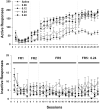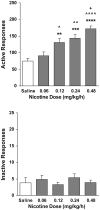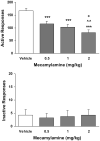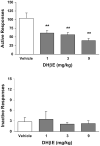Reinforcement enhancing effect of nicotine and its attenuation by nicotinic antagonists in rats
- PMID: 17616849
- PMCID: PMC2826146
- DOI: 10.1007/s00213-007-0863-3
Reinforcement enhancing effect of nicotine and its attenuation by nicotinic antagonists in rats
Abstract
Rationale: Recent studies have demonstrated that nicotine can enhance operant responding for other nonpharmacological reinforcing stimuli. However, the nature of the reinforcement-enhancing effect of nicotine remains largely unknown.
Objective: The present study determined the dose dependency of the ability of nicotine to increase lever-pressing responses maintained by a compound visual stimulus (VS) in rats and examined its sensitivity to pharmacological antagonism of nicotinic acetylcholine receptors (nAChRs).
Materials and methods: Male Sprague-Dawley rats were trained in daily 1-h sessions to lever press for delivery of a VS (1 s lever light on and 60 s house light off) on a fixed ratio 5 schedule. During these sessions, eight scheduled response-independent intravenous infusions of nicotine (total amount: 0, 0.06, 0.12, 0.24, 0.48 mg kg(-1) h(-1)) were delivered. In pharmacological tests, a nonselective nAChR antagonist mecamylamine, alpha4beta2-selective antagonist dihydro-beta-erythroidine (DHbetaE), and alpha7-selective antagonist methyllycaconitine (MLA) were administered in different groups of rats 30 min before the session.
Results: The VS maintained a moderate level of lever-pressing responses and nicotine dose-dependently increased responses for the VS presentations. Preteatment of mecamylamine and DHbetaE but not MLA significantly attenuated the nicotine-enhanced responding. However, mecamylamine had no effect on responding for the VS in rats that received scheduled saline infusions.
Conclusions: These results demonstrate dose dependency of the reinforcement-enhancing effect of nicotine and suggest that activation of the alpha4beta2- but not alpha7-containing nAChRs may mediate this effect.
Figures






Similar articles
-
Nicotine-induced enhancement of responding for conditioned reinforcement in rats: role of prior nicotine exposure and α4β2 nicotinic receptors.Psychopharmacology (Berl). 2013 Jan;225(2):429-40. doi: 10.1007/s00213-012-2832-8. Epub 2012 Aug 11. Psychopharmacology (Berl). 2013. PMID: 22885874
-
Effects of blockade of α4β2 and α7 nicotinic acetylcholine receptors on cue-induced reinstatement of nicotine-seeking behaviour in rats.Int J Neuropsychopharmacol. 2014 Jan;17(1):105-16. doi: 10.1017/S1461145713000874. Epub 2013 Aug 19. Int J Neuropsychopharmacol. 2014. PMID: 23953129 Free PMC article.
-
Evaluation of the role of nicotinic acetylcholine receptor subtypes and cannabinoid system in the discriminative stimulus effects of nicotine in rats.Eur J Pharmacol. 2006 Jul 1;540(1-3):96-106. doi: 10.1016/j.ejphar.2006.04.034. Epub 2006 May 3. Eur J Pharmacol. 2006. PMID: 16730696
-
The contribution of α4β2 and non-α4β2 nicotinic acetylcholine receptors to the discriminative stimulus effects of nicotine and varenicline in mice.Psychopharmacology (Berl). 2017 Mar;234(5):781-792. doi: 10.1007/s00213-016-4514-4. Epub 2016 Dec 27. Psychopharmacology (Berl). 2017. PMID: 28028600 Free PMC article.
-
The role of nicotinic acetylcholine receptors in the primary reinforcing and reinforcement-enhancing effects of nicotine.Neuropsychopharmacology. 2007 May;32(5):1098-108. doi: 10.1038/sj.npp.1301228. Epub 2006 Nov 8. Neuropsychopharmacology. 2007. PMID: 17091131 Free PMC article.
Cited by
-
Effects of economy type and nicotine on the essential value of food in rats.J Exp Anal Behav. 2012 Mar;97(2):183-202. doi: 10.1901/jeab.2012.97-183. J Exp Anal Behav. 2012. PMID: 22389525 Free PMC article.
-
Facilitation of intravenous nicotine self-administration in rats by a motivationally neutral sensory stimulus.Psychopharmacology (Berl). 2009 Dec;207(2):191-200. doi: 10.1007/s00213-009-1647-8. Epub 2009 Sep 16. Psychopharmacology (Berl). 2009. PMID: 19756529
-
Phasic Dopamine Release Magnitude Tracks Individual Differences in Sensitization of Locomotor Response following a History of Nicotine Exposure.Sci Rep. 2020 Jan 13;10(1):173. doi: 10.1038/s41598-019-56884-z. Sci Rep. 2020. PMID: 31932634 Free PMC article.
-
Effects of the phencyclidine model of schizophrenia and nicotine on total and categorized ultrasonic vocalizations in rats.Behav Pharmacol. 2016 Jun;27(4):321-30. doi: 10.1097/FBP.0000000000000199. Behav Pharmacol. 2016. PMID: 26479849 Free PMC article.
-
Reinforcer devaluation as a consequence of acute nicotine exposure and withdrawal.Psychopharmacology (Berl). 2015 May;232(9):1583-94. doi: 10.1007/s00213-014-3792-y. Epub 2014 Nov 18. Psychopharmacology (Berl). 2015. PMID: 25401169 Free PMC article.
References
-
- Alkondon M, Pereira EF, Wonnacott S, Albuquerque EX. Blockade of nicotinic currents in hippocampal neurons defines methyllycaconitine as a potent and specific receptor antagonist. Mol Pharmacol. 1992;41:802–808. - PubMed
-
- Brunzell DH, Chang JR, Schneider B, Olausson P, Taylor JR, Picciotto MR. Beta2-subunit-containing nicotinic acetylcholine receptors are involved in nicotine-induced increases in conditioned reinforcement but not progressive ratio responding for food in C57BL/6 mice. Psychopharmacology (Berl) 2006;184:328–338. - PubMed
-
- Caggiula AR, Donny EC, White AR, Chaudhri N, Booth S, Gharib MA, Hoffman A, Perkins KA, Sved AF. Cue dependency of nicotine self-administration and smoking. Pharmacol Biochem Behav. 2001;70:515–530. - PubMed
-
- Caggiula AR, Donny EC, White AR, Chaudhri N, Booth S, Gharib MA, Hoffman A, Perkins KA, Sved AF. Environmental stimuli promote the acquisition of nicotine self-administration in rats. Psychopharmacology (Berl) 2002;163:230–237. - PubMed
-
- Chaudhri N, Caggiula AR, Donny EC, Palmatier MI, Liu X, Sved AF. Complex interactions between nicotine and nonpharmacological stimuli reveal multiple roles for nicotine in reinforcement. Psychopharmacology (Berl) 2006;184:353–366. - PubMed
Publication types
MeSH terms
Substances
Grants and funding
LinkOut - more resources
Full Text Sources

